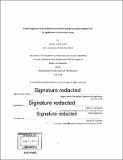| dc.contributor.advisor | Jeffrey C. Grossman. | en_US |
| dc.contributor.author | Smith, Brendan Derek | en_US |
| dc.contributor.other | Massachusetts Institute of Technology. Department of Materials Science and Engineering. | en_US |
| dc.date.accessioned | 2018-09-17T15:50:39Z | |
| dc.date.available | 2018-09-17T15:50:39Z | |
| dc.date.copyright | 2018 | en_US |
| dc.date.issued | 2018 | en_US |
| dc.identifier.uri | http://hdl.handle.net/1721.1/117935 | |
| dc.description | Thesis: Ph. D., Massachusetts Institute of Technology, Department of Materials Science and Engineering, 2018. | en_US |
| dc.description | Cataloged from PDF version of thesis. | en_US |
| dc.description | Includes bibliographical references (pages 125-138). | en_US |
| dc.description.abstract | This thesis introduces two chemical etching-based methods for the production of nanoporous silicon, improving on current state-of-the-art fabrication strategies in terms of scalability and simplicity. The developed processes also allow for new opportunities with respect to pore size, pore aspect ratio, and large-scale homogeneity. The first approach utilizes solution-casting of core-shell nanoparticle catalysts, where the shell is employed as a sacrificial spacer layer to maintain separation between etching-active catalyst cores. A second technique utilizing sputter-deposition of catalyst is developed with the goal of improving process scalability and homogeneity. With no intrinsic limitations on substrate size, this approach is used to produce nanoporous silicon over areas larger than 25 cm 2, pores less than 5 nm in diameter, and aspect ratios greater than 1000:1. Post-etch modification of the nanoporous silicon is performed by atomic layer deposition of alumina, titania, and tungsten nitride onto the surface and pore walls of the porous silicon, highlighting its morphological and chemical tunability. Utility of the material is demonstrated via its implementation in three industrially relevant use cases. As a nanofiltration membrane the material exhibits a size-cutoff as low as 2 nm, and tunable thickness-dependent permeability ranging over three orders of magnitude. Additionally, it demonstrates promise as an active material in a thermoelectric device, reducing thermal conductivity by approximately 70 fold with respect to bulk silicon, of which a factor of 20 can be attributed directly to the porosity in the film. Finally, applicability to the patterning of 2D materials is demonstrated using centimeter scale nanoporous silicon masks in the dry etching of molybdenum disulfide and tungsten disulfide, producing porous structures on the nanoscale. The broad impact of this work is the introduction of two new strategies for the manufacturing of nanoporous silicon at scale, and introduction of the relevant design metrics for control of pore size, pore aspect ratio, and homogeneity of the material. It is expected that this knowledge will be of use in applications which stand to benefit from the introduction of this unique form of nanoporous silicon. | en_US |
| dc.description.statementofresponsibility | by Brendan Derek Smith. | en_US |
| dc.format.extent | 138 pages | en_US |
| dc.language.iso | eng | en_US |
| dc.publisher | Massachusetts Institute of Technology | en_US |
| dc.rights | MIT theses are protected by copyright. They may be viewed, downloaded, or printed from this source but further reproduction or distribution in any format is prohibited without written permission. | en_US |
| dc.rights.uri | http://dspace.mit.edu/handle/1721.1/7582 | en_US |
| dc.subject | Materials Science and Engineering. | en_US |
| dc.title | A novel approach to the scalable production of nanoporous silicon membranes for applications in water and energy | en_US |
| dc.type | Thesis | en_US |
| dc.description.degree | Ph. D. | en_US |
| dc.contributor.department | Massachusetts Institute of Technology. Department of Materials Science and Engineering | |
| dc.identifier.oclc | 1051236431 | en_US |
